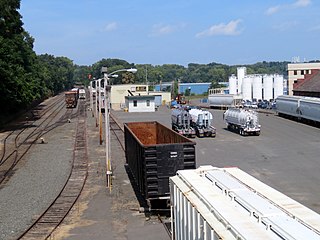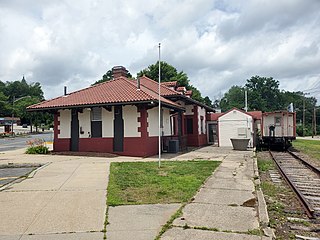Related Research Articles

The Providence and Worcester Railroad is a Class II railroad operating 612 miles (985 km) of tracks in Rhode Island, Massachusetts, and Connecticut, as well as New York via trackage rights. The company was founded in 1844 to build a railroad between Providence, Rhode Island, and Worcester, Massachusetts, and ran its first trains in 1847. A successful railroad, the P&W subsequently expanded with a branch to East Providence, Rhode Island, and for a time leased two small Massachusetts railroads. Originally a single track, its busy mainline was double-tracked after a fatal 1853 collision in Valley Falls, Rhode Island.

The New York and New England Railroad (NY&NE) was a railroad connecting southern New York State with Hartford, Connecticut; Providence, Rhode Island; and Boston, Massachusetts. It operated under that name from 1873 to 1893. Prior to 1873 it was known as the Boston, Hartford and Erie Railroad, which had been formed from several smaller railroads that dated back to 1846. After a bankruptcy in 1893, the NY&NE was reorganized and briefly operated as the New England Railroad before being leased to the competing New York, New Haven and Hartford Railroad in 1898.

The Massachusetts Central Railroad is a short line railroad in western Massachusetts, United States. It was established in 1975 to provide railroad transportation services on portions of the Boston & Maine Wheelwright Branch in and around their trackage in Bondsville and Ware, and later between Palmer and South Barre on the old right-of-way of the Ware River Railroad.

The Housatonic Railroad is a Class III railroad operating in southwestern New England and eastern New York. It was chartered in 1983 to operate a short section of ex-New York, New Haven and Hartford Railroad in northwestern Connecticut, and has since expanded north and south, as well as west into New York State.

The Central New England Railroad is a railroad in and near Hartford, Connecticut. It began operations in 1995 on former Conrail trackage.

The Connecticut Southern Railroad is a 90-mile (140 km) long short-line railroad operating in Connecticut and Massachusetts. The company was formed in 1996 as a spinoff of Conrail by shortline holding company RailTex and subsequently acquired in 2000 by RailAmerica. Since 2012, it has been a subsidiary of Genesee & Wyoming. CSO is headquartered in Hartford, Connecticut, site of its Hartford Yard. The company also operates East Hartford Yard.
The Bordentown Secondary was originally a freight railroad line in New Jersey, running from Pavonia Yard in Camden to Trenton. Today, a large portion of the line from Bordentown to Camden is used for New Jersey Transit's River Line light rail service. Conrail Shared Assets Operations continues to operate freight trains on the line, but these operations are restricted to overnight hours.

The East Junction Branch is a rail line in Rhode Island and Massachusetts, in the United States. Originally built by the Boston and Providence Railroad (B&P) in 1835, the line connects Attleboro, Massachusetts, and East Providence, Rhode Island via Seekonk, Massachusetts. As built, the line continued across the Seekonk River to Providence via the India Point Railroad Bridge; this connection was removed during the 1970s. The East Junction Branch meets the Northeast Corridor in Attleboro at a point known as East Junction, and ends at a connection to the East Providence Branch in East Providence. CSX Transportation operates freight service on the branch in Attleboro, while the Providence and Worcester Railroad (P&W) operates freight service in East Providence and across the state line into Seekonk. The line is owned by the P&W in Rhode Island, and by the Massachusetts Bay Transportation Authority in Massachusetts.

The Connecticut Company was the primary electric street railway company in the U.S. state of Connecticut, operating both city and rural trolleys and freight service. It was controlled by the New York, New Haven and Hartford Railroad, which also controlled most steam railroads in the state. After 1936, when one of its major leases was dissolved, it continued operating streetcars and, increasingly, buses in certain Connecticut cities until 1976, when its assets were purchased by the state government.

The Hartford and New Haven Railroad (H&NH), chartered in 1833, was the first railroad built in the state of Connecticut and an important direct predecessor of the New York, New Haven and Hartford Railroad. The company was formed to connect the cities of New Haven, Connecticut, and Springfield, Massachusetts. It built northwards from New Haven, opening its first segment in 1838, and reaching Hartford in December 1839. The company reached Springfield in 1844 under the auspices of the Hartford and Springfield Railroad, a subsidiary chartered in Massachusetts. Branches were later built to Suffield, New Britain, and Middletown and operated by the Hartford and New Haven. The H&NH merged with the New York and New Haven Railroad in 1872, forming the New York, New Haven and Hartford Railroad.

The Norwich and Worcester Railroad (N&W) was a railroad in the U.S. states of Connecticut and Massachusetts. Its north-south mainline ran between its namesake cities of Worcester, Massachusetts, and Norwich, Connecticut,. The Providence and Worcester Railroad (P&W) owns the ex-N&W line and operates freight service.

The Pioneer Valley Railroad, founded in 1982, is a Class III short line freight railroad operating the former Conrail trackage in the western part of Massachusetts in towns of Westfield, Holyoke, and Southampton. The railroad has been owned by the Pinsly Railroad Company since its founding, with headquarters in Westfield, Massachusetts.

The Boston and New York Air-Line Railroad was a railroad in Connecticut. Envisioned as a direct route between New Haven and Boston, it was hampered by difficult terrain in eastern Connecticut and did not find much success. The New York, New Haven and Hartford Railroad leased the company in 1882. The tracks between Portland, Connecticut and Willimantic, Connecticut were abandoned in 1965, while the remainder of the line is operated by the Providence and Worcester Railroad.

The Connecticut Valley Railroad was a railroad in the state of Connecticut founded in 1868. The company built a line along the Connecticut River between Hartford and Old Saybrook, which opened in 1871. It was reorganized as the Hartford and Connecticut Valley Railroad in 1880, and leased by the New York, New Haven and Hartford Railroad in 1887. Following partial abandonments by the New Haven Railroad and successor Penn Central Transportation Company between 1968 and 1972, the line south of Middletown was revived as the Valley Railroad, a heritage railroad, while the portion in Middletown and northward saw operation by several freight railroads. As of 2022, the Providence and Worcester Railroad and Connecticut Southern Railroad both operate portions of the former Connecticut Valley Railroad.
The Delmarva Central Railroad is an American short-line railroad owned by Carload Express that operates 188 miles (303 km) of track on the Delmarva Peninsula in the states of Delaware, Maryland, and Virginia. The railroad operates lines from Porter, Delaware to Hallwood, Virginia and from Harrington, Delaware to Frankford, Delaware along with several smaller branches. The DCR interchanges with the Norfolk Southern Railway and the Maryland and Delaware Railroad. The railroad was created in 2016 to take over the Norfolk Southern Railway lines on the Delmarva Peninsula. The DCR expanded by taking over part of the Bay Coast Railroad in 2018 and the Delaware Coast Line Railroad in 2019.

Cedar Hill Yard is a classification yard located in New Haven, North Haven and Hamden, Connecticut, United States. It was built by the New York, New Haven and Hartford Railroad in the early 1890s in and around New Haven's Cedar Hill neighborhood, which gave the yard its name. Electrical catenary for electric locomotives was added to the yard in 1915. To handle increasing traffic as a result of World War I, the yard was greatly expanded between 1917 and 1920 with additional construction along both sides of the Quinnipiac River. The construction project added two humps where railroad cars were sorted into trains by gravity. The yard was further modernized in the 1920s, becoming one of the busiest railroad yards in the United States, and the most important yard in the entire New Haven Railroad system.

The Connecticut Central Railroad was a railroad in Connecticut and Massachusetts, which connected East Hartford, Connecticut and Springfield, Massachusetts. Founded in 1871, it was built between 1874 and 1876, and operated independently until being leased by the New York and New England Railroad in 1880. In the 21st century, the line remains in service between East Hartford and Scantic, Connecticut, and out of service to the Massachusetts state line, beyond which it has been abandoned.

Northup Avenue Yard is a rail yard located in Providence and Pawtucket, Rhode Island, in the United States. The location has been the site of a rail yard since at least 1899. It was significantly expanded by the New York, New Haven and Hartford Railroad between 1918 and 1921 and made into a hump yard. The hump was removed around 1970, after Penn Central Transportation Company took over the New Haven in 1969. Under Penn Central, the yard was downsized and the hump removed. Conrail superseded Penn Central in 1976 and sold off the yard to the Providence and Worcester Railroad in 1982.

The Meriden, Waterbury, and Connecticut River Railroad was a railroad in the state of Connecticut. The charter, originally granted in 1871 to the Meriden and Cromwell Railroad, was obtained by Meriden residents and construction began in 1883. The line opened between the city of Meriden, Connecticut, and the Connecticut River in Cromwell, Connecticut, in 1885. An extension to Waterbury, Connecticut, was completed in 1888 as the Meriden and Waterbury Railroad, and the two companies merged to form the Meriden, Waterbury and Connecticut Railroad.

The Southbridge Branch was a railway line in Connecticut and Massachusetts, United States. It ran 16.9 miles (27.2 km) between Southbridge, Massachusetts and East Thompson, Connecticut, via Webster, Massachusetts. Originally planned to be part of the Southbridge and Blackstone Railroad, it was ultimately built in 1866–67 by the Boston, Hartford and Erie Railroad. It became part of the New York and New England Railroad in 1875, and the New York, New Haven and Hartford Railroad in 1898. Passenger service ended in 1930, and the eastern portion of the line was abandoned in 1937. The western half continued to be used for freight service; it passed to Penn Central in 1969, and to the Providence and Worcester Railroad (P&W) in 1976 as the Southbridge Running Track. The P&W stopped serving the line in the 1980s, but did not abandon it until 2004. Much of the western half of the line in Massachusetts has been converted to the Quinebaug Valley Rail Trail.
References
- ↑ McGonigal, Robert S. (February 5, 2024). "Understanding railroad reporting marks". Trains. Retrieved 2024-08-06.
- ↑ "Connecticut Central Railroad Records". doddcenter.uconn.edu/. Archives & Special Collections at the Thomas J. Dodd Research Center. Archived from the original on 21 September 2013. Retrieved 1 September 2014.
- 1 2 3 4 Waters, Martin J. (April 8, 2001). "Here's a switch: Derelict rail line is back on track". Record-Journal . Meriden, Connecticut. pp. A1, A4. Retrieved October 25, 2021.
- 1 2 Fazzalaro, James. "Re: Rail Facilities in Middletown". www.cga.ct.gov/olr. Office of Legislative Research. Retrieved 1 September 2014.
- ↑ "Providence & Worcester Railroad Operations Freight Schedule List". www.pwrfc.net/. Providence and Worcester Railfan Club and Museum. Retrieved 1 September 2014.
- ↑ "2013 Connecticut Rail Line Name and Location Identification Map" (PDF). www.ct.gov/dot/. Connecticut Department of Transportation. Retrieved 1 September 2014.